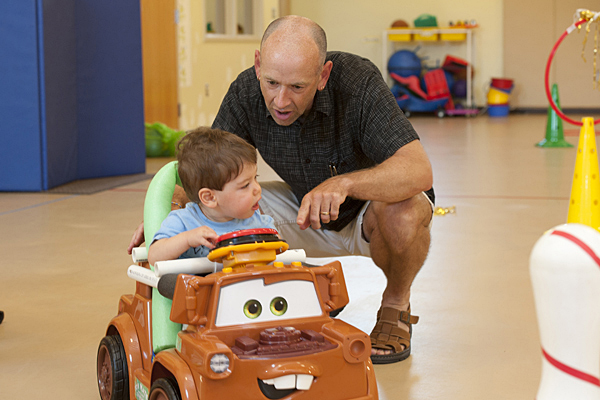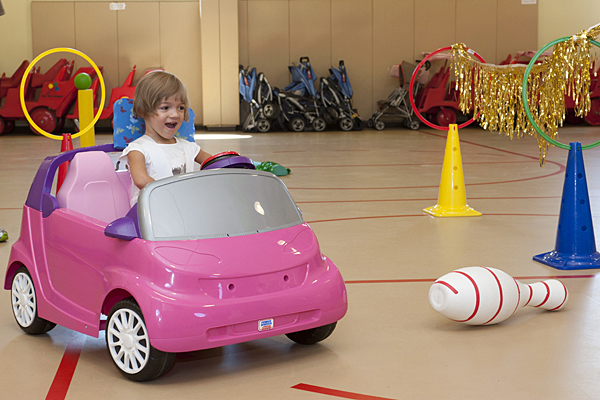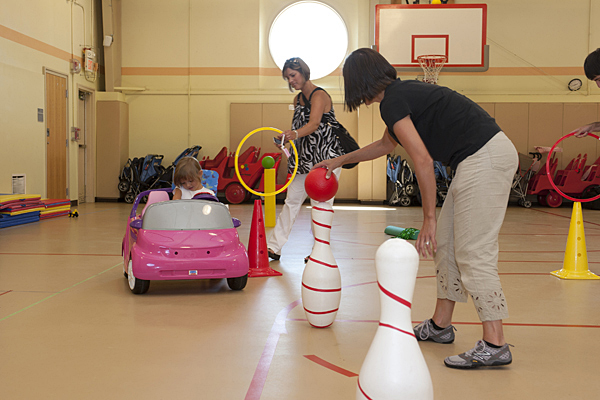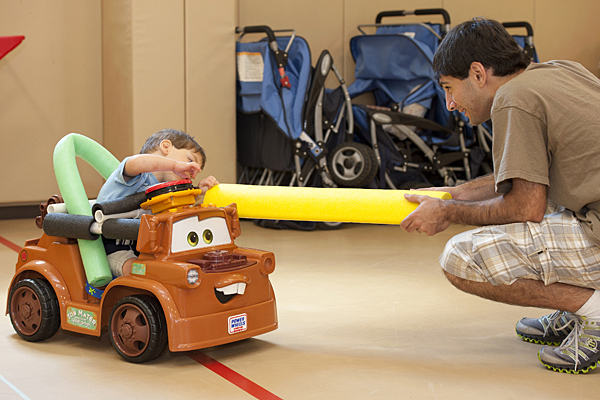

Javascript is required to view this video
Babies, start your engines
Toy ride-on cars provide mobility and sociability to kids with disabilities
9:37 a.m., Sept. 23, 2011--Most university researchers find their collaborators at other academic institutions. Cole Galloway finds his at Toys “R” Us.
Best known for his “babies driving robots” research, Galloway has recently turned to off-the-shelf toy racecars to provide mobility to children who can’t crawl or walk, empowering them to be part of the action at home, in the daycare center, or on the playground.
Research Stories
Chronic wounds
Prof. Heck's legacy
An associate professor in the Department of Physical Therapy at the University of Delaware, Galloway has long focused the research in his lab on improving the odds for kids whose mental, social and emotional development is delayed because of their physical inability to explore their environment. With collaborator Sunil Agrawal, a mechanical engineering professor at UD, Galloway has created robotic devices that enable children as young as six months to “drive,” providing them with an unprecedented ability to navigate on their own.
But as successful as the program has been, Galloway gets phone calls and emails from parents and clinicians across the U.S. and even in other countries wanting to buy the devices. He has to tell them they can’t.
“Development of the devices has moved at the speed of research,” Galloway says. “We’re continuously advancing the technology, but it hasn’t been commercialized yet.”
Enter some new team members you might recognize: Barbie, Mater, and Lightning McQueen.
“Using these cars in our project helps to normalize the therapeutic experience for children with limited mobility,” Galloway says. “The other kids are pushing in, wanting to know when they can have a turn.”
He points out that the low-tech isn’t replacing the high-tech but complementing it. “There’s a lot of trial and error in research,” Galloway says. “We really don’t know where we’re going here. By modifying off-the-shelf toy cars that cost $150 or $200 each, we can make a lot of mistakes and learn a lot about the ideal configurations and features of mobility devices for kids this age.”
Visitors to UD’s Early Learning Center, which serves as Galloway’s test track, will notice that while the cars are the real deal from the toy store, they have some added features—roll bars made out of PVC pipe, sling seats made from soft fabric, harnesses fashioned from mesh and plastic, and a specialized console over the steering wheel.
Galloway and his team adapt each car to the needs of the child who is currently using it. One of his newest team members is David Glanzman, a rising junior at Strath Haven High School in Wallingford, Pa., who participated in a research internship program sponsored by UD’s Engineering Outreach Office this summer.
The sixteen-year-old engineered some of the adaptations to Mater so that it would meet the needs of 19-month-old Brenden, who has cerebral palsy. With plans to pursue a career in electrical engineering, Glanzman gained valuable insight into what happens when engineering meets kids.
“In electrical engineering, you have problems with defined solutions,” he says. “It’s different with pediatrics. Kids are dynamic, and they change over time—you have to be creative to adapt to that.” Glanzman is finishing out his summer project by helping Galloway to develop some tracking features for the cars so that they can be sent home with kids and still provide the researchers with data.
One of Galloway’s larger goals for the racecar project is to take what he and his team are learning and create a toolkit for others who want to adapt the cars for kids with special needs. He emphasizes the importance of doing this right.
“We make sure to stay within the manufacturers’ intent, which is to use these cars as toys,” he says. “We don’t alter their use, and we don’t alter the safety factors built into the cars.”
The next step is to determine how many of the high-tech advances that have been incorporated into the robotic devices developed in Agrawal’s lab at UD can be added to the low-tech platform, including for example, indoor and outdoor GPS.
Galloway says that recent developments in the commercial toy car industry have opened the door for his team’s therapeutic use of the vehicles. Until a few years ago, for example, the cars were not recommended for children under age three. Now, some of the smaller ones can be used by children as young as 12 months. Also, some cars come with the ability for a parent to provide remote control.
Galloway also emphasizes that in both the low- and high-tech realms of his research, the use of mobility devices never replaces efforts to develop a child’s own ability to walk and run. “We’re actually finding that providing mobility with these fun cars helps develop the mental drive for kids to learn to walk,” he says.
He himself never stops looking for creative ways to help individual children while also seeking avenues to spread the message and the technology to parents and clinicians. One idea he is currently exploring is to pilot a summer racecar camp. The research team would outfit the campers with cars, have them spend a week at the camp learning to drive, and then send the kids and cars home. The children’s progress would be monitored for the next six to nine months.
“Fun is the key here—it unlocks brain development,” Galloway says. “When your main goal is providing socialization for infants and toddlers, you can’t ask for better collaborators than Barbie and Mater.”
Article by Diane Kukich
Video by Christian Derr
Photos by Kathy F. Atkinson












